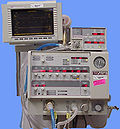Respiratory failure: Difference between revisions
CSV import Tags: mobile edit mobile web edit |
CSV import |
||
| Line 27: | Line 27: | ||
{{stub}} | {{stub}} | ||
<gallery caption="Respiratory failure"> | |||
File:Respiratory failure.jpg|Respiratory failure | |||
File:Respiratory failure.jpg|Respiratory failure | |||
File:RespiratoryFailureTypes.png|Types of respiratory failure | |||
File:Clubbing of fingers in IPF.jpg|Clubbing of fingers in IPF | |||
File:Arterial blood gas device.jpg|Arterial blood gas device | |||
File:VIP Bird2.jpg|Ventilator device | |||
</gallery> | |||
Revision as of 01:27, 20 February 2025
Respiratory failure is a syndrome in which the respiratory system fails in one or both of its gas exchange functions: oxygenation and carbon dioxide elimination. This can lead to an abnormal arterial oxygen and carbon dioxide concentration. The definition of respiratory failure in clinical trials usually includes increased respiratory rate, abnormal blood gases (hypoxemia, hypercapnia, or both), and evidence of increased work of breathing.
Types
There are two types of respiratory failure: type 1 and type 2.
Type 1 respiratory failure is defined as a low level of oxygen in the blood (hypoxemia) without an increased level of carbon dioxide in the blood (hypercapnia), and can occur due to a malfunction at any stage in the oxygen delivery process, from the airway to the alveoli.
Type 2 respiratory failure is defined as a low level of oxygen in the blood with an increased level of carbon dioxide. This typically occurs when there is an inability to remove CO2 via the lung.
Causes
Respiratory failure can be caused by a variety of conditions, including lung diseases such as chronic obstructive pulmonary disease (COPD), pneumonia, pulmonary edema, and lung cancer, as well as conditions that affect the nerves and muscles that control breathing, such as amyotrophic lateral sclerosis (ALS).
Treatment
Treatment for respiratory failure depends on whether the condition is acute (short-term) or chronic (ongoing), and its severity. It often involves use of supplemental oxygen and, in severe cases, a ventilator.







